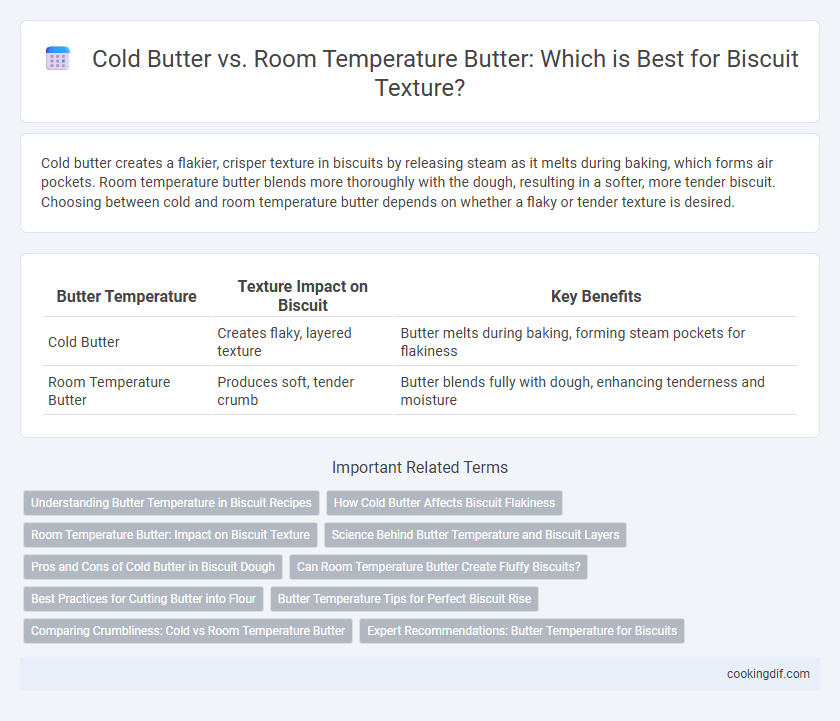Cold butter creates a flakier, crisper texture in biscuits by releasing steam as it melts during baking, which forms air pockets. Room temperature butter blends more thoroughly with the dough, resulting in a softer, more tender biscuit. Choosing between cold and room temperature butter depends on whether a flaky or tender texture is desired.
Table of Comparison
| Butter Temperature | Texture Impact on Biscuit | Key Benefits |
|---|---|---|
| Cold Butter | Creates flaky, layered texture | Butter melts during baking, forming steam pockets for flakiness |
| Room Temperature Butter | Produces soft, tender crumb | Butter blends fully with dough, enhancing tenderness and moisture |
Understanding Butter Temperature in Biscuit Recipes
Cold butter creates flakier biscuits by producing steam pockets during baking, while room temperature butter results in a softer, more cohesive texture. Understanding butter temperature is crucial for controlling the final crumb structure and tenderness in biscuit recipes. Bakers often chill their butter to achieve the ideal balance between flaky layers and a tender bite.
How Cold Butter Affects Biscuit Flakiness
Cold butter creates steam pockets during baking, which enhances the flakiness of biscuits by forming distinct, layered textures. As butter melts slowly in the oven, it prevents the dough from overmixing and becoming dense, resulting in light, airy biscuits. Using cold butter ensures that layers remain separate, producing a tender crumb and an ideal flaky texture.
Room Temperature Butter: Impact on Biscuit Texture
Room temperature butter blends evenly into biscuit dough, creating small pockets of fat that melt during baking and produce a tender, flaky texture. This soft butter incorporates smoothly with flour, promoting a consistent crumb structure without dense or greasy spots. As a result, biscuits made with room temperature butter typically rise better and have a light, fluffy interior compared to those using cold butter.
Science Behind Butter Temperature and Biscuit Layers
Cold butter creates distinct layers in biscuits because it remains solid during baking, causing steam to form and separate the dough, resulting in a flaky texture. Room temperature butter blends into the dough more completely, producing a softer, denser biscuit with fewer layers. The science behind butter temperature reveals that maintaining cold butter is essential for achieving optimal flakiness through steam expansion and laminated dough structure.
Pros and Cons of Cold Butter in Biscuit Dough
Cold butter in biscuit dough creates a flaky texture by forming small pockets of steam during baking, which helps the biscuits rise and separate. Its main advantage is producing tender, layered biscuits, but it can be challenging to work with as it requires quick handling to prevent melting and uneven dough consistency. The downside is that if the butter warms too much, biscuits may turn dense and lose their characteristic flakiness.
Can Room Temperature Butter Create Fluffy Biscuits?
Room temperature butter can create fluffy biscuits by incorporating air into the dough, which helps achieve a light, tender texture. The soft consistency allows for even mixing and proper gluten development while maintaining moisture. Cold butter, when cut into the flour, produces flakier biscuits but may result in a denser crumb compared to room temperature butter.
Best Practices for Cutting Butter into Flour
Cold butter is ideal for achieving a flaky texture in biscuits because it creates small pockets of steam during baking, resulting in a light and tender crumb. Room temperature butter blends more thoroughly with flour, producing a denser and more uniform texture, often preferred for softer biscuits. Best practices for cutting butter into flour include using a pastry cutter or two knives to maintain small, pea-sized butter pieces, ensuring even distribution and optimal flakiness.
Butter Temperature Tips for Perfect Biscuit Rise
Using cold butter in biscuit dough creates steam during baking, resulting in flaky, layered textures as the butter melts and releases moisture. Room temperature butter blends evenly into the dough, producing a tender, softer crumb but less distinct flakiness. For perfect biscuit rise, incorporate small, chilled butter pieces to maximize steam pockets while avoiding overmixing to maintain dough structure.
Comparing Crumbliness: Cold vs Room Temperature Butter
Cold butter creates a flakier, crumblier texture in biscuits due to its slower melting during baking, which forms distinct layers. Room temperature butter blends more thoroughly into the dough, resulting in a denser, less crumbly biscuit. Premixing cold butter into flour creates pockets of fat, essential for achieving optimal biscuit crumb structure.
Expert Recommendations: Butter Temperature for Biscuits
Experts recommend using cold butter for biscuits to achieve a flaky, tender texture by creating distinct layers during baking. Room temperature butter, while easier to blend, tends to produce a softer, more cake-like crumb due to thorough mixing. For optimal biscuit quality, incorporating cold, solid butter ensures proper steam generation and flakiness, as emphasized by professional bakers.
Cold butter vs Room temperature butter for texture Infographic

 cookingdif.com
cookingdif.com